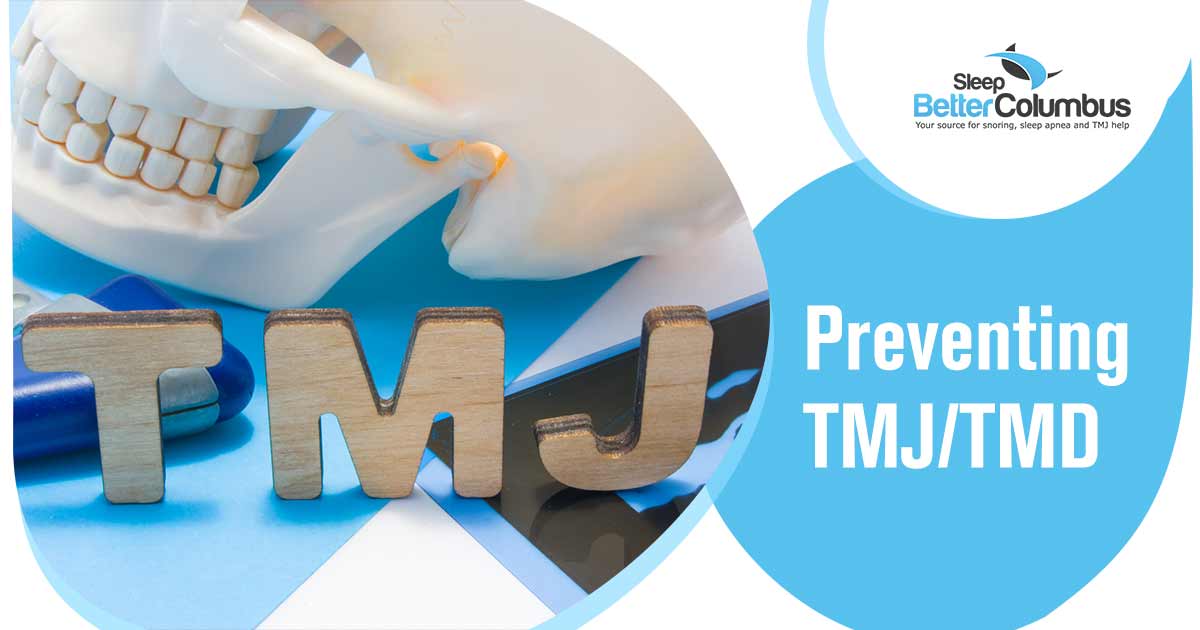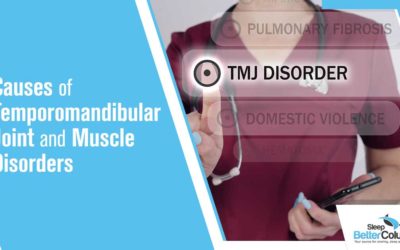Temporomandibular joint (TMJ) disorders can cause pain in the jaw joints and the muscles and ligaments controlling jaw movement. TMJ disorders, sometimes referred to as temporomandibular dysfunctions (TMD), can have a significant impact on your life by affecting your ability to speak easily, chew, or yawn. The TMD experts at Sleep Better Columbus are dedicated to improving and preventing TMJ/TMD symptoms.
Types of TMD (temporomandibular dysfunctions)
- Disorders of the chewing muscles, the most common form of TMD, can cause myofascial pain. Myofascial pain is pain or discomfort in the fascia (connective tissue covering the muscles) and muscles controlling jaw, neck, and shoulder function.
- Disorders of the jaw joints, including disc disorders and degenerative joint diseases, such as osteoarthritis.
- Headaches resulting from TMD and/or the associated pain.
Causes of TMJ Disorders
The exact cause of a person’s TMJ disorder is hard to pinpoint, and the pain is usually from a combination of factors, which can be jaw injury, arthritis, or genetics.
TMJ causes may include:
- Bruxism (grinding or clenching the teeth)
- Malocclusion (improper alignment of your top and bottom teeth)
- Arthritis in the jaw joint
- Jaw injuries, such as a dislocated or broken jaw
- Stress
Symptoms of TMJ Disorders
TMJ disorder symptoms vary widely. People may experience jaw pain, facial pain, and/or shoulder or neck pain. The pain a person feels from TMD can range from mild to severe with some people experiencing chronic pain. Common signs and symptoms of temporomandibular joint dysfunction include:
- Pain in the jaw joint and/or chewing muscles (the most common symptom)
- Difficulty chewing or pain while chewing
- Pain in one or both temporomandibular joints
- Aching pain in and around your ear
- Pain or tenderness of the jaw
- Stiffness in your jaw
- Aching facial pain
- Swelling of the side of the face
- Toothaches
- Pain that spreads to the face and/or neck
- Shoulder or neck pain
- Tinnitus (ringing in the ears), hearing loss, or dizziness
- Headaches and/or migraines
- Blurred vision
- Limited movement or locking of the temporomandibular joint, making it difficult to open or close your mouth
- Painful clicking, grating, or popping in your jaw joint when you open or close your mouth
- Changes in how your upper and lower teeth align or fit together
TMJ disorders can cause a clicking sound, a grating sensation, or popping in your jaw joint when opening and closing your mouth or chewing that causes pain and/or limits jaw movement.
Sounds without pain in the temporomandibular joints are normal, happen often, and do not need treatment.
Managing and Preventing TMJ/TMD Flare-ups
Any number of things can create issues with your TMJ disorder, but you can take steps to prevent flare-ups and minimize pain and discomfort if you do have a TMD flare-up.
The first preventive measure you can take is recognizing any activities that might cause a flare-up or increase your pain or discomfort. Once you’ve identified these activities, you can work on avoiding them or taking steps to prevent them from occurring. For example, if you have sleep bruxism (grinding or clenching your teeth at night while sleeping), you can wear a mouth guard at night. If you experience pain and discomfort after eating hard, difficult-to-chew foods like taffy, gummy candies, or jerky, avoid eating these foods as much as possible.
Things That Make TMJ Disorders Worse
While you might not be able to control the factors that cause TMJ disorders, you can control things that can make your TMD, and its symptoms, worse. Being aware of these habits can help when it comes to avoiding or preventing TMJ/TMD symptoms so you can decrease pain and TMJ disorder flare-ups.
Habits that can make temporomandibular disorders worse include:
- Chewing on pens, pencils, toothpicks, or other items (These habits are often related to anxiety.)
- Chewing ice, lollipops, or other hard candies
- Excessively chewing gum
- Grinding or clenching your teeth during the daytime
- Taking large bites of food (This overworks jaw muscles.)
- Sleeping on your stomach
- Using your teeth as tools (e.g., opening packages, tearing tags off clothes, holding items, opening bottle caps)
Treatment Options for Temporomandibular Joint (TMJ) Disorders
For many people, the pain and discomfort from TMJ disorders is temporary and can be relieved with home remedies, self-managed care, and/or other nonsurgical treatments.
Most home remedies deal with managing pain. Typical home remedies include using ice packs and taking over-the-counter pain medications like ibuprofen, acetaminophen, or naproxen. While home remedies may help reduce the pain, they are temporary solutions and won’t always resolve the problems for long periods of time.
Sedatives, muscle relaxers, and pain relievers can be used to help treat TMJ disorders. Sedatives can help you sleep more peacefully at night. Muscle relaxers will help relax the muscles in the area. Muscle relaxers are often paired with pain relievers that help with the immediate pain.
Self-managed care options are all the activities you can do yourself. These activities can include learning everything you can about your type of temporomandibular joint disorder, identifying activities that cause TMD flare-ups, setting specific goals for managing your condition, and learning meditation and relaxation techniques to reduce and/or eliminate stress that might be contributing to TMJ pain or lead to habits that cause TMJ pain (e.g., clenching or grinding teeth, chewing on non-food items).
Other Options for Preventing TMJ/TMD Pain
Additional nonsurgical treatment options for TMJ disorders that do not involve medications include using a bite guard while you sleep or occasionally during the day, wearing a dental splint or mouth guard to realign the jaw, or physical therapy options. Physical therapy for temporomandibular dysfunctions typically includes stretches and exercises to strengthen the jaw along with using ice and moist heat.
If you have a severe case, your dentist or doctor may suggest other more aggressive treatment options. Corticosteroid injections directly into the joint can be helpful. Arthrocentesis, a medical procedure during which the jaw joint is washed out with sterile fluid to rinse away any debris, may also be helpful. If these and other nonsurgical treatments are not effective, surgery may be suggested as a last resort. Surgical options are generally only used when there is something structurally wrong with the joint of a patient with a TMJ disorder.
What to Do If You Think You Have a TMJ Disorder
If you think you have a TMJ Disorder or have been diagnosed with one, do not ignore the effects of it. Take steps to avoid things that can increase pain or worsen the condition. Consult a dentist or doctor who can help you find ways to treat the condition. Fortunately, there are multiple things a person can do to manage temporomandibular joint disorders, decrease pain, and eliminate symptoms.




